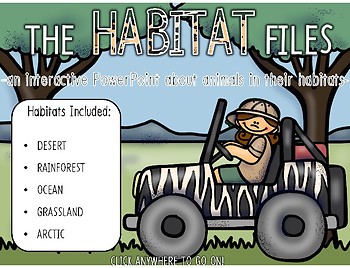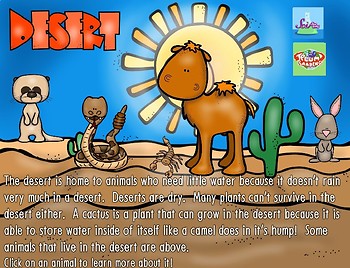Habitat Powerpoint: Interactive Safari
Louisiana Littles
414 Followers
Grade Levels
K - 3rd
Subjects
Resource Type
Standards
NGSS1-LS1-1
NGSS1-LS1-2
NGSS2-LS4-1
NGSSK-LS1-1
Formats Included
- PPTX
Pages
32 pages
Louisiana Littles
414 Followers
What educators are saying
I loved using this resource to learn about habitats before going to the zoo. There are many resources included in these slides that my students loved.
Description
This is an interactive powerpoint focusing on animals and their habitats. Included are five different habitats:
1. desert
2. rainforest
3. ocean
4. savannah
5. arctic
Each of these slides has links to videos. You can click on the animals to learn more about that animal.
I hope you love this product! Please check out some of my other products.
Total Pages
32 pages
Answer Key
N/A
Teaching Duration
N/A
Report this resource to TPT
Reported resources will be reviewed by our team. Report this resource to let us know if this resource violates TPT’s content guidelines.
Standards
to see state-specific standards (only available in the US).
NGSS1-LS1-1
Use materials to design a solution to a human problem by mimicking how plants and/or animals use their external parts to help them survive, grow, and meet their needs. Examples of human problems that can be solved by mimicking plant or animal solutions could include designing clothing or equipment to protect bicyclists by mimicking turtle shells, acorn shells, and animal scales; stabilizing structures by mimicking animal tails and roots on plants; keeping out intruders by mimicking thorns on branches and animal quills; and, detecting intruders by mimicking eyes and ears.
NGSS1-LS1-2
Read texts and use media to determine patterns in behavior of parents and offspring that help offspring survive. Examples of patterns of behaviors could include the signals that offspring make (such as crying, cheeping, and other vocalizations) and the responses of the parents (such as feeding, comforting, and protecting the offspring).
NGSS2-LS4-1
Make observations of plants and animals to compare the diversity of life in different habitats. Emphasis is on the diversity of living things in each of a variety of different habitats. Assessment does not include specific animal and plant names in specific habitats.
NGSSK-LS1-1
Use observations to describe patterns of what plants and animals (including humans) need to survive. Examples of patterns could include that animals need to take in food but plants do not; the different kinds of food needed by different types of animals; the requirement of plants to have light; and, that all living things need water.





